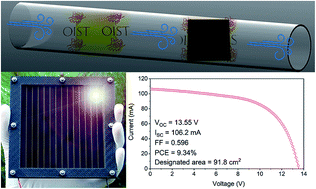Hybrid chemical vapor deposition enables scalable and stable Cs-FA mixed cation perovskite solar modules with a designated area of 91.8 cm2 approaching 10% efficiency†
Abstract
The development of scalable deposition methods for stable perovskite layers is a prerequisite for the development and future commercialization of perovskite solar modules. However, there are two major challenges, i.e., scalability and stability. In sharp contrast to a previous report, here we develop a fully vapor based scalable hybrid chemical vapor deposition (HCVD) process for depositing Cs-formamidinium (FA) mixed cation perovskite films, which alleviates the problem encountered when using conventional solution coating of mainly methylammonium lead iodide (MAPbI3). Using our HCVD method, we fabricate perovskite films of Cs0.1FA0.9PbI2.9Br0.1 with enhanced thermal and phase stabilities, by the intimate incorporation of Cs into FA based perovskite films. In addition, the SnO2 electron transport layer (ETL) (prepared by sputter deposition) is found to be damaged during the HCVD process. In combination with precise interface engineering of the SnO2 ETL, we demonstrate relatively large area solar modules with efficiency approaching 10% and with a designated area of 91.8 cm2 fabricated on 10 cm × 10 cm substrates (14 cells in series). On the basis of our preliminary operational stability tests on encapsulated perovskite solar modules, we extrapolated that the T80 lifetime is approximately 500 h (under the light illumination of 1 sun and 25 °C).



 Please wait while we load your content...
Please wait while we load your content...